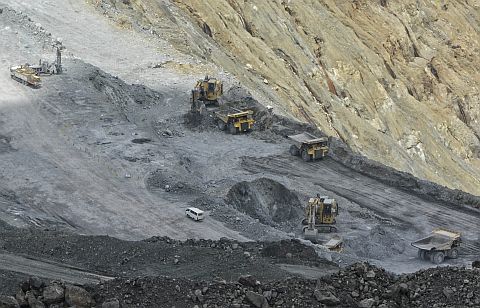
Mining firm, Carmen Copper Corp., with its Carmen pit, and power companies such as Therma Visayas Inc. with its power plant (below) are among Toledo City’s economic drivers.
CDN PHOTO/Christian Maningo and contributed photo/Risa Rafols
BOOMING TOLEDO CITY EYES HOUSING INVESTORS
We are going to build a Tañon Strait economy.”
Mayor John Henry “Sonny” Osmeña said this in a phone interview, as he described the local government’s thrust to make Toledo City, which was once described as a ghost town in western Cebu, into a booming metropolis.
Osmeña cited the growing interests of more property investors on building more horizontal housing developments in this city, which is 50 km west of Cebu City or a one-hour drive via the Naga-Uling road from Cebu City.
He said that Toledo City is adding at least 6,000 houses to its inventory.
“We are going to have a very active housing project in Toledo. We want to increase the population of the city to 250,000 by 2020 from the current 170,000,” Osmeña said.
He said several private Cebu-based investors had expressed interest to build housing communities in the city, although he did not divulge who these were and when these projects would materialize.
“We want to bring the people who are suffering from the traffic and the garbage and the pollution in Cebu City and Metro Cebu to Toledo,” he said.
At present, there are not so many housing communities in the city, but the local chief executive is optimistic that people will go there once residential developments start rising in the area.
The mayor said people would want to live in Toledo because traffic is not a problem there, the economy is booming, and they still have a lot of available space for development.
Toledo City’s total land area spans approximately 216.28 kilometers, composed of flatlands and hilly terrain.
Economic drivers
The mayor also cited the factors that continue to drive the city’s economy, which are power, mining and woodcraft.
“With power, mining, and the growing industry, including woodcraft, Toledo is booming,” he told Cebu Daily News.
The mining industry is among the major drivers of the city’s economy.
Carmen Copper Corp. (CCC), which operates the Toledo copper mine in Barangay Don Andres Soriano, has paid P1.47 billion in excise taxes from 2011 to 2016, 40 percent of which went to the local government.
The mining company also presently employs 2,500 workers, 80 percent of which are from Toledo City.
Aside from mining, communities in the city are also dependent on fishing and farming.
Power
In recent years, however, the availability of land and the city’s booming economy have led to the establishment of newer power generation facilities.
Among these are the 60-Megawatt solar power plant by SunAsia, the 350-MW power plant by the Aboitiz-led Therma Visayas, Inc., and a 264-MW coal-fired power plant by Global Business Power Corp.
Osmeña said the city’s income went up to P4 billion at present from P400 million in 2013, which is 10 times more, due to a rise of industrial activities, new power plants, and other trading activities.
Challenge
Osmeña said the challenge for the local government now in terms of attracting businesses is the inadequate port.
“Shipment intended for Toledo has to go to the port in Cebu City because the ships cannot dock here. We all know how congested it is in Cebu City, causing higher shipping fees,” he said.
He added that they are now working on building another pier in the locality, although he could not divulge specifics yet.
Osmeña said they also plan to establish an industrial economic zone in the city, which is also in line with the Cebu provincial government’s plan for Toledo.
Economic zone
“Toledo is among the areas we project to have economic zones in the west, along with Balamban,” said Roy Soledad, head of the Cebu Investment Promotions Office (CIPO).
Soledad said he also sees potential in Toledo City as an industrial economic zone, concentrating on light manufacturing or heavy industries and even on power on top of the existing mining industry.
Marketing
Moving forward, he said Toledo must be more active in marketing what it has to prospective investors.
He said it needs to come up with an updated land use plan as well as an investment and incentives code to help guide interested investors.
This as Toledo City and the rest of western Cebu face stiff competition in terms of share of development with the towns and cities in the southern and eastern parts of the province.
As the lone city in the west, Toledo is expected to take the lead because it has the potential to do so.
Business mix
While mining provides income to the city and employment to the people, Soledad said the local government should not be contented with that sector alone.
“A city or municipality must have a diverse mix of businesses,” he said, adding that diversity makes a locality more attractive to other prospective investors.
He said that as the local government continues to develop other sectors to spur its economy, more people will flock to the city.
The local governments closest to Cebu City are now getting more industrially saturated, and that it would be good to spread development farther into the countryside.
“People will transfer there and that’s what we want, proper distribution. When there is economic activity, people will go there,” Soledad said.